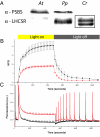Physcomitrella patens mutants affected on heat dissipation clarify the evolution of photoprotection mechanisms upon land colonization
- PMID: 20505121
- PMCID: PMC2890724
- DOI: 10.1073/pnas.1002873107
Physcomitrella patens mutants affected on heat dissipation clarify the evolution of photoprotection mechanisms upon land colonization
Abstract
Light is the source of energy for photosynthetic organisms; when in excess, however, it also drives the formation of reactive oxygen species and, consequently, photoinhibition. Plants and algae have evolved mechanisms to regulate light harvesting efficiency in response to variable light intensity so as to avoid oxidative damage. Nonphotochemical quenching (NPQ) consists of the rapid dissipation of excess excitation energy as heat. Although widespread among oxygenic photosynthetic organisms, NPQ shows important differences in its machinery. In land plants, such as Arabidopsis thaliana, NPQ depends on the presence of PSBS, whereas in the green alga Chlamydomonas reinhardtii it requires a different protein called LHCSR. In this work, we show that both proteins are present in the moss Physcomitrella patens. By generating KO mutants lacking PSBS and/or LHCSR, we also demonstrate that both gene products are active in NPQ. Plants lacking both proteins are more susceptible to high light stress than WT, implying that they are active in photoprotection. These results suggest that NPQ is a fundamental mechanism for survival in excess light and that upon land colonization, photosynthetic organisms evolved a unique mechanism for excess energy dissipation before losing the ancestral one found in algae.
Conflict of interest statement
The authors declare no conflict of interest.
Figures





References
-
- Barber J, Andersson B. Too much of a good thing: Light can be bad for photosynthesis. Trends Biochem Sci. 1992;17:61–66. - PubMed
-
- Li Z, Wakao S, Fischer BB, Niyogi KK. Sensing and responding to excess light. Annu Rev Plant Biol. 2009;60:239–260. - PubMed
-
- Rensing SA, et al. The Physcomitrella genome reveals evolutionary insights into the conquest of land by plants. Science. 2008;319:64–69. - PubMed
-
- Waters ER. Molecular adaptation and the origin of land plants. Mol Phylogenet Evol. 2003;29:456–463. - PubMed
Publication types
MeSH terms
Substances
LinkOut - more resources
Full Text Sources
Other Literature Sources
Molecular Biology Databases
Research Materials

